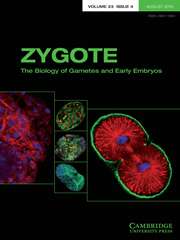No CrossRef data available.
Article contents
Association of growth differentiation factor 9 expression with nuclear receptor and basic helix-loop-helix transcription factors in buffalo oocytes during in vitro maturation
Published online by Cambridge University Press: 11 November 2024
Abstract
Growth differentiation factor 9 (GDF9) is an oocyte-specific paracrine factor involved in bidirectional communication, which plays an important role in oocyte developmental competence. In spite of its vital role in reproduction, there is insufficient information about exact transcriptional control mechanism of GDF9. Hence, present study was undertaken with the aim to study the expression of basic helix-loop-helix (bHLH) transcription factors (TFs) such as the factor in the germline alpha (FIGLA), twist-related protein 1 (TWIST1) and upstream stimulating factor 1 and 2 (USF1 and USF2), and nuclear receptor (NR) superfamily TFs like germ cell nuclear factor (GCNF) and oestrogen receptor 2 (ESR2) under three different in vitro maturation (IVM) groups [follicle-stimulating hormone (FSH), insulin-like growth factor-1 (IGF1) and oestradiol)] along with all supplementation group as positive control, to understand their role in regulation of GDF9 expression. Buffalo cumulus–oocyte complexes were aspirated from abattoir-derived ovaries and matured in different IVM groups. Following maturation, TFs expression was studied at 8 h of maturation in all four different IVM groups and correlated with GDF9 expression. USF1 displayed positive whereas GCNF, TWIST1 and ESR2 revealed negative correlation with GDF9 expression. TWIST1 & ESR2 revealing negative correlation with GDF9 expression were found to be positively correlated amongst themselves also. GCNF & USF1 revealing highly significant correlation with GDF9 expression in an opposite manner were found to be negatively correlated. The present study concludes that the expression of GDF9 in buffalo oocytes remains under control through the involvement of NR and bHLH TFs.
Keywords
- Type
- Research Article
- Information
- Copyright
- © The Author(s), 2024. Published by Cambridge University Press



